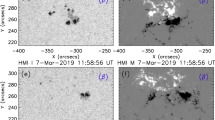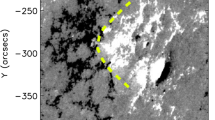Abstract
We carried out a multi-wavelength study of a Coronal Mass Ejection (CME) and an associated flare, occurring on 12 May 1997. We present a detailed investigation of magnetic-field variations in NOAA Active Region 8038 which was observed on the Sun during 7 – 16 May 1997. This region was quiet and decaying and produced only a very small flare activity during its disk passage. However, on 12 May 1997 it produced a CME and associated medium-size 1B/C1.3 flare. Detailed analyses of Hα filtergrams and SOHO/MDI magnetograms revealed continual but discrete surge activity, and emergence and cancellation of flux in this active region. The movie of these magnetograms revealed the two important results that the major opposite polarities of pre-existing region as well as in the emerging-flux region were approaching towards each other and moving magnetic features (MMF) were ejected from the major north polarity at a quasi-periodicity of about ten hours during 10 – 13 May 1997. These activities were probably caused by magnetic reconnection in the lower atmosphere driven by photospheric convergence motions, which were evident in magnetograms. The quantitative measurements of magnetic-field variations such as magnetic flux, gradient, and sunspot rotation revealed that in this active region, free energy was slowly being stored in the corona. Slow low-layer magnetic reconnection may be responsible for the storage of magnetic free energy in the corona and the formation of a sigmoidal core field or a flux rope leading to the eventual eruption. The occurrence of EUV brightenings in the sigmoidal core field prior to the rise of a flux rope suggests that the eruption was triggered by the inner tether-cutting reconnection, but not the external breakout reconnection. An impulsive acceleration, revealed from fast separation of the Hα ribbons of the first 150 seconds, suggests that the CME accelerated in the inner corona, which is also consistent with the temporal profile of the reconnection electric field. Based on observations and analysis we propose a qualitative model, and we conclude that the mass ejections, filament eruption, CME, and subsequent flare were connected with one another and should be regarded within the framework of a solar eruption.
Similar content being viewed by others
References
Archontis, V., Hood, A.W., Savcheva, A., Golub, L., Deluca, E.: 2009, Astrophys. J. 691, 1276.
Aurass, H., Vrsnak, B., Hofmann, A., Rudzjak, V.: 1999, Solar Phys. 190, 267.
Bharti, L., Jain, R., Joshi, C., Jaaffrey, S.N.A.: 2005, In: Sankarasubramanian, K., Penn, M., Pevtsov, A. (eds.) Large-Scale Structures and Their Role in Solar Activity CS-346, Astron. Soc. Pac., San Francisco, 327.
Bharti, L., Rimmele, T., Jain, R., Jaaffrey, S.N.A., Smart, R.N.: 2007, Mon. Not. Roy. Astron. Soc. 376(3), 1291.
Chae, J., Wang, H.M., Qiu, J., Goode, P.R., Strous, L., Yun, H.S.: 2001, Astrophys. J. 560, 476.
Cheng, X., Zhang, J., Ding, M.D.: 2010, Astrophys. J. 712, 1302.
Chumak, O.V.: 2005, Astron. Astrophys. Trans. 24, 93.
Dai, Y., Auchère, F., Vial, J.C., Tang, Y.H., Zong, W.G.: 2010, Astrophys. J. 708, 913.
Démoulin, P., Aulanier, G.: 2010, Astrophys. J. 718, 1388.
Green, L.M., Kliem, B.: 2009, Astrophys. J. Lett. 700, L83.
Harrison, R.A., Bryans, P., Simnett, G.M., Lyons, M.: 2003, Astron. Astrophys. 400, 1071.
Harra, L.K., Sterling, A.C.: 2001, Astrophys. J. Lett. 561, L215.
Harra, L.K., Hara, H., Imada, S., Young, P.R., Williams, D.R., Sterling, A.C., Korendyke, C., Attrill, G.D.R.: 2007, Publ. Astron. Soc. Japan 59, S801.
Hirayama, T.: 1974, Solar Phys. 34, 323.
Imada, S., Hara, H., Watanabe, T., Kamio, S., Asai, A., Matsuzaki, K., Harra, L.K., Mariska, J.T.: 2007, Publ. Astron. Soc. Japan 59, S793.
Jain, R.: 1983, Ph.D. Thesis, Gujarat University, Ahmedabad, India.
Jin, M., Ding, M.D., Chen, P.F., Fang, C., Imada, S.: 2009, Astrophys. J. 702, 27.
Kliem, B., Török, T.: 2006, Phys. Rev. Lett. 96, 255002.
Kopp, R.A., Pneuman, G.W.: 1976, Solar Phys. 50, 85.
Li, P., Emslie, A.G., Mariska, J.T.: 1993, Astrophys. J. 417, 313.
Li, Y., Lynch, B.J., Welsch, B.T., Stenborg, G.A., Luhmann, J.G., Fisher, G.H., Liu, Y., Nightingale, R.W.: 2010, Solar Phys. 264, 149.
Liu, Y.: 2004, J. Atmos. Solar-Terr. Phys. 66, 1283.
Liu, C., Lee, J., Yurchyshyn, V., Deng, N., Cho, K.: 2007, Astrophys. J. 669, 1372.
Martens, P.C.H., Kuin, N.P.M.: 1989, Solar Phys. 122, 263.
Mathew, S.K., Ambastha, A.: 2000, Solar Phys. 197, 75.
Moore, R.L., Sterling, A.C., Hudson, H.S., Lemen, J.R.: 2001, Astrophys. J. 552, 933.
Ohyama, M., Shibata, K.: 1997, Publ. Astron. Soc. Japan 49, 249.
Plunkett, S.P., Thompson, B.J., Howard, R.A., Michels, D.J., St. Cyr, O.C., Tappin, S.J., Schwenn, R., Lamy, P.L.: 1998, Geophys. Res. Lett. 25, 2477.
Press, W.H., Flannery, B.P., Teukolsky, S.A.: 1992, Numerical Recipes in C: The Art of Scientific Computing, Cambridge University Press, Cambridge.
Qiu, J., Wang, H., Cheng, C.Z., Gary, D.E.: 2004, Astrophys. J. 604, 900.
Reinard, A.A., Biesecker, D.A.: 2008, Astrophys. J. 674, 576.
Reinard, A.A., Biesecker, D.A.: 2009, Astrophys. J. 705, 914.
Robbrecht, E., Wang, Y.-M.: 2010, Astrophys. J. Lett. 720, L88.
Schmieder, B.: 2006, J. Astrophys. Astron. 27, 139.
Shibata, K., Masuda, S., Shimojo, M., Hara, H., Yokoyama, T., Tsuneta, S., Kosugi, T., Ogawara, Y.: 1995, Astrophys. J. Lett. 451, L83.
Shibata, K.: 1996, Adv. Space Res. 17, 197.
Shibata, K.: 1998, In: Watanbe, T., Kosugi, T., Sterling, A.C. (eds.) Observational Plasma Astrophysics: Five Years of Yohkoh and Beyond, Kluwer, Dordrecht, 187.
Sterling, A.C., Harra, L.K., Moore, R.L.: 2007, Astrophys. J. 669, 1359.
Subramanian, P., Dere, K.P.: 2001, Astrophys. J. 561, 372 S.
Temmer, M., Veronig, A.M., Vršnak, B., Rybák, J., Gömöry, P., Stoiser, S., Maričić, D.: 2008, Astrophys. J. 673, L95.
Tian, L., Alexander, D., Nightingale, R.: 2008, Astrophys. J. 684, 747.
Titov, V.S., Mikic, Z., Linker, J.A., Lionello, R.: 2008, Astrophys. J. 675, 1614.
Tripathi, D., Kliem, B., Mason, H.E., Young, P., Green, L.M.: 2009, Astrophys. J. Lett. 698, L27.
Török, T., Kliem, B.: 2005, Astrophys. J. Lett. 630, L97.
Tsuneta, S.: 1997, Astrophys. J. 483, 507.
Tsuneta, S., Hara, H., Shimizu, T., Acton, L.W., Strong, K.T., Hudson, H.S., Ogawara, Y.: 1992, Publ. Astron. Soc. Japan 44, L63.
Thompson, B.J., Plunkett, S.P., Gurman, J.B., Newmark, J.S., St. Cyr, O.C., Michels, D.J.: 1998, Geophys. Res. Lett. 25, 2465.
Van Tend, W., Kuperus, M.: 1978, Solar Phys. 59, 115.
Welsch, B.T., DeVore, C.R., Antiochos, S.K.L.: 2005, Astrophys. J. 634, 1395.
Zhang, J., Dere, K.P., Howard, R.A., Vourlidas, A.: 2004, Astrophys. J. 604, 420.
Zhang, Y., Liu, J., Zhang, H.: 2008, Solar Phys. 247, 39.
Author information
Authors and Affiliations
Corresponding author
Rights and permissions
About this article
Cite this article
Jain, R., Awasthi, A.K., Chandel, B. et al. Probing the Role of Magnetic-Field Variations in NOAA AR 8038 in Producing a Solar Flare and CME on 12 May 1997. Sol Phys 271, 57–74 (2011). https://doi.org/10.1007/s11207-011-9793-7
Received:
Accepted:
Published:
Issue Date:
DOI: https://doi.org/10.1007/s11207-011-9793-7




